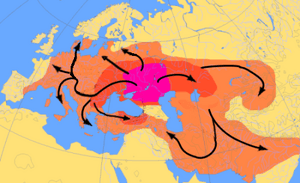Kurgan hypothesis facts for kids
The Kurgan model of Indo-European origins is about both the people and their Proto-Indo-European language.
It uses both archaeology and linguistics to show the history of their culture at different stages of the Indo-European expansion.
Contents
Background
When it was first suggested in 1956, Marija Gimbutas's answer to the question of Indo-European origins was a pioneering interdisciplinary synthesis of archaeology and linguistics. From the nineties on, new archaeological evidence from Northern European prehistoric cultures was put forward on the influence and expansion of Kurgan cultures.
Related pages
Images for kids
See also
 In Spanish: Hipótesis de los kurganes para niños
In Spanish: Hipótesis de los kurganes para niños

All content from Kiddle encyclopedia articles (including the article images and facts) can be freely used under Attribution-ShareAlike license, unless stated otherwise. Cite this article:
Kurgan hypothesis Facts for Kids. Kiddle Encyclopedia.



